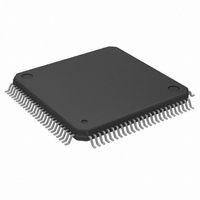D12312SVF20V Renesas Electronics America, D12312SVF20V Datasheet - Page 634

D12312SVF20V
Manufacturer Part Number
D12312SVF20V
Description
IC H8S/2312S MCU ROMLESS 100QFP
Manufacturer
Renesas Electronics America
Series
H8® H8S/2300r
Specifications of D12312SVF20V
Core Processor
H8S/2000
Core Size
16-Bit
Speed
20MHz
Connectivity
SCI, SmartCard
Peripherals
POR, PWM, WDT
Number Of I /o
70
Program Memory Type
ROMless
Ram Size
8K x 8
Voltage - Supply (vcc/vdd)
2.7 V ~ 3.6 V
Data Converters
A/D 8x10b; D/A 2x8b
Oscillator Type
Internal
Operating Temperature
-20°C ~ 75°C
Package / Case
100-QFP
For Use With
EDK2329 - DEV EVALUATION KIT H8S/2329
Lead Free Status / RoHS Status
Lead free / RoHS Compliant
Eeprom Size
-
Program Memory Size
-
Available stocks
Company
Part Number
Manufacturer
Quantity
Price
Company:
Part Number:
D12312SVF20V
Manufacturer:
Renesas Electronics America
Quantity:
10 000
- Current page: 634 of 1146
- Download datasheet (7Mb)
Section 17 ROM
17.7.3
Flash memory erasing should be performed block by block following the procedure shown in the
erase/erase-verify flowchart (single-block erase) shown in figure 17.16.
For the wait times (x, y, z, α, ß, γ, ε, η, θ) after bits are set or cleared in flash memory control
register 1 (FLMCR1) and the maximum number of programming operations (N), see section
20.3.6, Flash Memory Characteristics.
To perform data or program erasure, make a 1 bit setting for the flash memory area to be erased in
erase block register 1 or 2 (EBR1 or EBR2) at least (x) μs after setting the SWE bit to 1 in flash
memory control register 1 (FLMCR1). Next, the watchdog timer is set to prevent overerasing in
the event of program runaway, etc. Set a value greater than (y + z + α + ß) ms as the WDT
overflow period. After this, preparation for erase mode (erase setup) is carried out by setting the
ESU bit in FLMCR1, and after the elapse of (y) μs or more, the operating mode is switched to
erase mode by setting the E bit in FLMCR1. The time during which the E bit is set is the flash
memory erase time. Ensure that the erase time does not exceed (z) ms.
Note: With flash memory erasing, prewriting (setting all data in the memory to be erased to 0) is
17.7.4
In erase-verify mode, data is read after memory has been erased to check whether it has been
correctly erased.
After the elapse of the erase time, erase mode is exited (the E bit in FLMCR1 is cleared to 0, then
the ESU bit in FLMCR1 is cleared to 0 at least (α) μs later), the watchdog timer is cleared after
the elapse of (β) μs or more, and the operating mode is switched to erase-verify mode by setting
the EV bit in FLMCR1. Before reading in erase-verify mode, a dummy write of H'FF data should
be made to the addresses to be read. The dummy write should be executed after the elapse of (γ)
μs or more. When the flash memory is read in this state (verify data is read in 16-bit units), the
data at the latched address is read. Wait at least (ε) μs after the dummy write before performing
this read operation. If the read data has been erased (all 1), a dummy write is performed to the next
address, and erase-verify is performed. If the read data has not been erased, set erase mode again,
and repeat the erase/erase-verify sequence in the same way. However, ensure that the erase/erase-
verify sequence is not repeated more than (N) times. When verification is completed, exit erase-
verify mode, and wait for at least (η) μs. If erasure has been completed on all the erase blocks,
clear the SWE bit in FLMCR1 to 0 and wait for at least (θ) μs. If there are any unerased blocks,
make a 1 bit setting for the flash memory area to be erased, and repeat the erase/erase-verify
sequence in the same way.
Rev.7.00 Feb. 14, 2007 page 600 of 1108
REJ09B0089-0700
not necessary before starting the erase procedure.
Erase Mode
Erase-Verify Mode
Related parts for D12312SVF20V
Image
Part Number
Description
Manufacturer
Datasheet
Request
R

Part Number:
Description:
KIT STARTER FOR M16C/29
Manufacturer:
Renesas Electronics America
Datasheet:

Part Number:
Description:
KIT STARTER FOR R8C/2D
Manufacturer:
Renesas Electronics America
Datasheet:

Part Number:
Description:
R0K33062P STARTER KIT
Manufacturer:
Renesas Electronics America
Datasheet:

Part Number:
Description:
KIT STARTER FOR R8C/23 E8A
Manufacturer:
Renesas Electronics America
Datasheet:

Part Number:
Description:
KIT STARTER FOR R8C/25
Manufacturer:
Renesas Electronics America
Datasheet:

Part Number:
Description:
KIT STARTER H8S2456 SHARPE DSPLY
Manufacturer:
Renesas Electronics America
Datasheet:

Part Number:
Description:
KIT STARTER FOR R8C38C
Manufacturer:
Renesas Electronics America
Datasheet:

Part Number:
Description:
KIT STARTER FOR R8C35C
Manufacturer:
Renesas Electronics America
Datasheet:

Part Number:
Description:
KIT STARTER FOR R8CL3AC+LCD APPS
Manufacturer:
Renesas Electronics America
Datasheet:

Part Number:
Description:
KIT STARTER FOR RX610
Manufacturer:
Renesas Electronics America
Datasheet:

Part Number:
Description:
KIT STARTER FOR R32C/118
Manufacturer:
Renesas Electronics America
Datasheet:

Part Number:
Description:
KIT DEV RSK-R8C/26-29
Manufacturer:
Renesas Electronics America
Datasheet:

Part Number:
Description:
KIT STARTER FOR SH7124
Manufacturer:
Renesas Electronics America
Datasheet:

Part Number:
Description:
KIT STARTER FOR H8SX/1622
Manufacturer:
Renesas Electronics America
Datasheet:

Part Number:
Description:
KIT DEV FOR SH7203
Manufacturer:
Renesas Electronics America
Datasheet:











